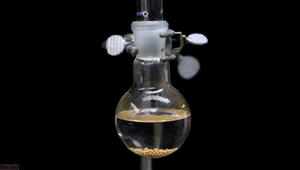Benzyl chloride
 Freshly dried benzyl chloride
| |
| Names | |
|---|---|
| IUPAC name
(Chloromethyl)benzene
| |
| Systematic IUPAC name
Chloromethylbenzene | |
| Other names
α-Chlorotoluene
Alpha-Chlorotoluene Benzylchloride | |
| Properties | |
| C7H7Cl | |
| Molar mass | 126.58 g/mol |
| Appearance | Colorless liquid |
| Odor | Pungent, aromatic |
| Density | 1.1004 g/cm3 (20 °C) |
| Melting point | −39 °C (−38 °F; 234 K) |
| Boiling point | 179 °C (354 °F; 452 K) |
| 0.0525 g/100 ml (25 °C) Slowly hydrolyzes at pH>7 | |
| Solubility | Miscible with glacial acetic acid, chloroform, dichloromethane, diethyl ether, ethanol, methanol Slightly soluble in carbon tetrachloride |
| Vapor pressure | 1 mmHg (20 °C) |
| Thermochemistry | |
| Hazards | |
| Safety data sheet | Sigma-Aldrich |
| Flash point | 67 °C (153 °F; 340 K) |
| Lethal dose or concentration (LD, LC): | |
| LD50 (Median dose)
|
1,231 mg/kg (rat, oral) |
| LC50 (Median concentration)
|
150 ppm (rat, 2 hr) 80 ppm (mouse, 2 hr) |
| Related compounds | |
| Related compounds
|
Benzyl alcohol Toluene |
| Except where otherwise noted, data are given for materials in their standard state (at 25 °C [77 °F], 100 kPa). | |
| Infobox references | |
Benzyl chloride or α-chlorotoluene, is an organochlorine compound with the chemical formula C6H5CH2Cl.
Contents
Properties
Chemical
Benzyl chloride will hydrolyze in water or basic conditions to benzyl alcohol, though its hydrolysis in liquid phase is slow.
In organic synthesis, benzyl chloride is used for the introduction of the benzyl protecting group in reaction with alcohols, yielding the corresponding benzyl ether, carboxylic acids, and benzyl ester.
Benzyl chloride also reacts readily with metallic magnesium in water-free conditions, to produce a Grignard reagent, extremely useful for the synthesis of various compounds containing an aromatic ring.
Physical
Benzyl chloride is a colorless to slight yellowish liquid, immiscible with water, but miscible with many organic solvents.
Availability
Benzyl chloride is sold by chemical suppliers, though it's difficult to acquire.
Benzyl chloride is classified as List II drug precursor chemical in most countries, in the US being classified as DEA List II chemical. The sale of this compound is restricted or monitored, due to its use in the synthesis of amphetamine-class drugs.
Preparation
There are several routes to benzyl chloride:
The most common route involves refluxing benzyl alcohol with an excess of fuming conc. hydrochloric acid. After the reaction has completed, let the product cool to room temperature. Benzyl chloride will appear as a layer on the top of the solution. Use a separatory funnel to remove the aqueous layer. Add a solution of sodium bicarbonate to the benzyl chloride layer in the funnel to neutralize any acid left. Shake the funnel to properly neutralize the acid from the layer. Remove the lower layer which now contains the benzyl chloride and then pour it back in a funnel, and wash it again, this time with a supersaturated solution of sodium chloride. Pour the benzyl chloride layer in another flask and dry it using a drying agent like calcium chloride or magnesium sulfate. To purify the compound, you will have to fractionally distill the crude product. The distilled benzyl chloride contains some water, which can be removed by using molecular sieves or some other drying agent.[1]
Benzyl chloride can also be produced through the Blanc reaction, where benzene reacts with formaldehyde in conc. hydrochloric acid or hydrogen chloride, in the presence of zinc chloride.
One SM user made benzyl chloride by dissolving chlorine gas in toluene, then added a small amount of lithium bromide. The lithium bromide acted as a precatalyst for bromine, which would form bromine monochloride in a solution containing large amounts of dissolved chlorine. Light is needed to initiate the reaction, but once it starts, there's no need to further expose the flask to strong light, unless your goal is to continue the reaction.[2]
Peroxide-catalyzed chlorination of toluene will also yield benzyl chloride.[3]
An interesting, but not verified, synthesis of benzyl chloride involves adding calcium hypochlorite to toluene and heating the mixture at 105 °C. If equal amounts of reagents are used, the yield of the reaction is good, however if more bleaching powder is used, side products like benzal chloride and benzotrichloride are also formed. If confirmed, this route would be very attractive due to the fact that both reagents are readily available. However, store-grade calcium hypochlorite is extremely impure, and you will have to determine first how much hypochlorite is present in the bleaching powder before using it.[4]
Projects
- Make benzyl alcohol
- Make denatonium benzoate
- Make benzyl esters
- Make benzoic acid
Handling
Safety
Benzyl chloride is corrosive and a lachrymator. It is also a suspected carcinogen.
Benzyl chloride will polymerize in contact with most metals, except nickel and lead. The process releases heat and HCl.
Storage
Benzyl chloride must be stored in all-glass containers, or amber bottles with a teflon seal, never in metals and away from moisture and or air. Propylene oxide is sometimes added as inhibitor, at concentrations between 0.25-1%.
Disposal
Benzyl chloride can be safely neutralized by reacting it with a base, in a large volume of water. Alternatively, an alcoholic solution of NaOH or KOH can be used.
References
- ↑ https://www.youtube.com/watch?v=lWFTYQ-x-SM
- ↑ http://www.sciencemadness.org/talk/viewthread.php?tid=14063
- ↑ Vogel, Practical Organic Chemistry, 3rd Ed.
- ↑ https://www.google.com/patents/US1280612
Relevant Sciencemadness threads
- Interesting benzyl chloride synth I discovered
- Alternative Benzyl Chloride Preps (for those who don't like Chlorine and some who Do)
- Benzyl chloride from Benzyl acetate
- Sketchy benzyl chloride synth.
- benzyl chloride
- BENZYL CHLORIDE PROBLEM
- benzyl chloride syn
- Benzyl Chloride Distillation
- Pink Benzyl Chloride
- Reactions of Benzyl chloride and Benzyl alcohol with anhydre acetic